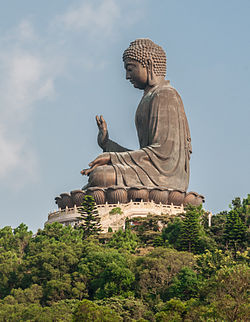Buddha
A Buddha is the holiest type of being in Buddhism, a teacher of gods and humans. The word Buddha means "enlightened one" in Sanskrit or Fully Awakened One in Pāli.
|
| |
|---|---|
|
Basic terms | |
|
| |
|
People | |
|
Schools | |
|
Practices | |
It is also a title for Siddhartha Gautama. He was the man who started Buddhism. Sometimes people call him "the Buddha" or the "Shakyamuni Buddha". Other times, people call any person a Buddha if they have found enlightenment. If a person has not found enlightenment yet, but is very close to reaching it, then he is called bodhisattva.
Summary
Buddhists believe that there have been many Buddhas, Gautama Buddha being merely the most famous. People who will become Buddhas someday are called "bodhisattvas."
Buddhists believe that the Buddha was enlightened, which means that he knew all about how to live a peaceful life and how to avoid suffering. He is said to have never argued with other people, but only said what was true and useful, out of compassion for others.[1]
Some Buddhists pray to Buddhas, but Buddhas are not gods. Buddhas are teachers who help the people who will listen. A Buddha is a human being who has woken up and can see the true way the world works. This knowledge totally changes the person so that they can have a better life in the present and the future. A Buddha can also help a person achieve enlightenment.
There are ideas or teachings which are said to lead someone to enlightenment. They are called the Dharma (Sanskrit) or "Dhamma" (Pāli), meaning "the way" or "the truth." Anyone can become a Buddha, but it is very difficult. Siddhartha Gautama became Buddha under the peepal or "bodhi" tree at Bodhgaya in Bihar in what is now India.
Types of Buddhas
There is a special type of Buddha called a pratyekabuddha or "silent Buddha". These Buddhas reached enlightenment on their own, but they did not teach others.
Another type of Buddha is a samyaksambuddha. This is the best kind of Buddha because he is able to teach all living beings.
Seven Buddhas of the past
Buddhists believe that there have been many Buddhas in the past. There will also be many Buddhas in the future. Traditionally, seven Buddhas are given names.
- Vipashyin Buddha
- Shikhin Buddha
- Vishvabhu Buddha
- Krakucchanda Buddha
- Kanakamuni Buddha
- Kashyapa Buddha
- Shakyamuni Buddha
Maitreya will be the next Buddha.
32 Signs of a Great Man
A Buddha is a person who has reached perfection. Some believe that there are 32 physical features of a Buddha; these are the 32 marks of a Great Man from Vedic Brahmin folklore, but are mentioned in the Pāli canon. Some of these features are represented in art and sculpture. These are listed below.
- Flat feet
- Thousand-spoked wheel symbol on feet
- Long, slender fingers
- Flexible hands and feet
- Webbed fingers and toes
- Full-sized heels
- Arched insteps
- Thighs like a royal stag
- Hands that reach below the knees
- Sheathed male organ
- Equal height and stretch of arms
- Dark-colored hair
- Graceful and curly body hair
- Golden-hued body
- Ten-foot halo around his body
- Soft, smooth skin
- Soles, palms, shoulders, and crown of head well-rounded
- Area below armpits filled out
- Lion-shaped body
- Erect and upright body
- Full, round shoulders
- Forty teeth
- White, even, and close teeth
- Four pure white canine teeth
- Jaw like a lion
- Saliva that improves the taste of all food
- Long and broad tongue
- Deep and resonant voice
- Deep blue eyes[2]
- Eyelashes like a royal bull
- White curl of hair (ūrṇā) that emits light between eyebrows
- Bump on the crown of the head
Related pages
References
- ↑ Ajahn Jagaro 1995, “What was the Buddha’s life really like?”[dead link]
- ↑ Epstein, Ronald (2003), Buddhist Text Translation Society's Buddhism A to Z (illustrated ed.), Burlingame, CA: Buddhist Text Translation Society, p. 200
3. “Chapter 3 Buddhism. Origins and Fundamental Tenets. .” Religions in the Modern World: Traditions and Transformations, section written by Cathy Cantwell & Hiroko Kawanami., Routledge, 2016, pp. 75–78

